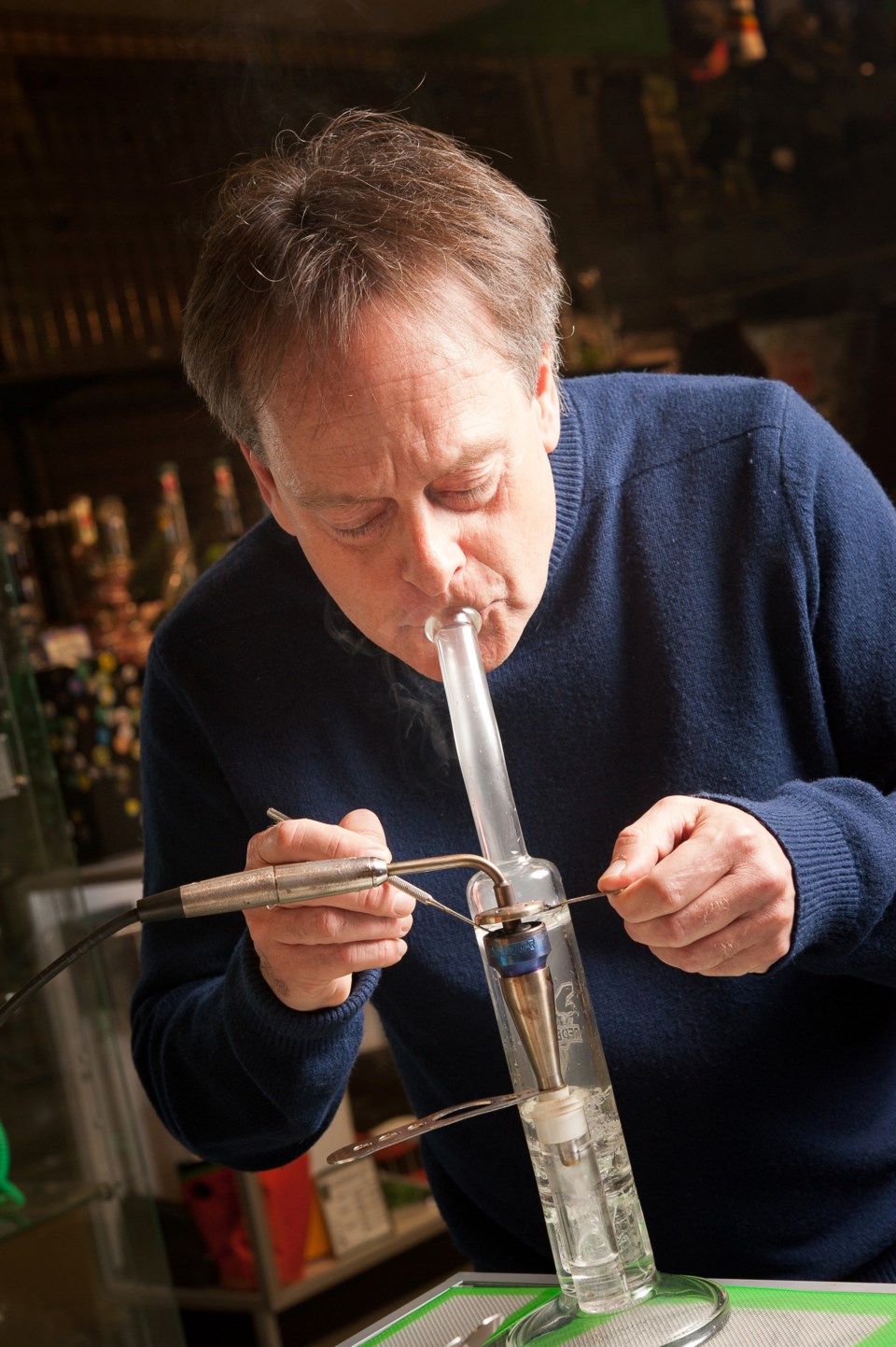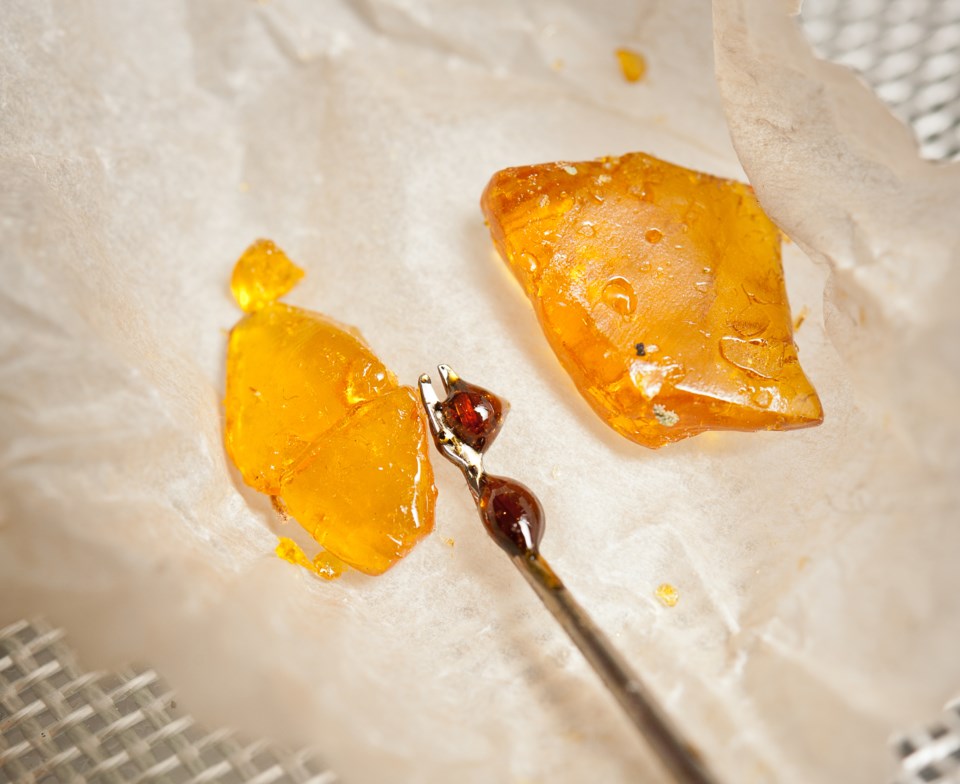Marc Emery is holding court at the back of Cannabis Culture, his weed-themed store and political headquarters on West Hastings Street.
Fresh off serving a five-year stint in jail in the United States for selling mail-order marijuana seeds across the border, the Vancouver activist is still every ounce the Prince of Pot he’s touted to be. In the past few months, however, he’s made room under his crown for a new moniker: the Duke of Dabs.
Dab, honey oil, budder, earwax, shatter – whatever street name you prefer for Butane Hash Oil (BHO), people are turning to the trendy cannabis concentrates in droves for stronger, faster, purer, and pricier THC highs.
And while hash oils and techniques like hot-knifing have been around since the 1970s, industry insiders have seen a full-blown renaissance in the past year, due largely, they say, to the fact that modern dabs can contain up to 90 per cent THC.
To clarify, THC stands for tetrahydrocannabinol (the psychoactive compound in marijuana) and that’s way stronger than your father’s hashish, or even today’s marijuana buds, which clock in at around 25 per cent. Ratios like that make dabbing about the most intense high an experienced (or inexperienced) pot user can find.
So for 18 weeks now, Emery has invited store customers to step up to his dab bar to see, for free, what all the hype is about.
“This is going to be very big around the world,” says Emery, between hits on his sublimator. “It’s just starting here; but everywhere you have pot you’ll have this. So what I’m trying to do is show people how to do it right, explain what’s going on, what it’s made of, and showing them what really amazing, top-end, $70-a-gram shatter is like.”

Since December, Emery says he has dabbed 2,850 volunteers – selecting the right shatter from his menu, carefully tweezing out a small amount of the sticky substance, and then touching it to a red-hot piece of metal on his sublimator to vaporize it for inhalation. More than half of his dabbers have said it was their first encounter with that form of the drug.
But as dabbing is gaining momentum in the living rooms and cannabis lounges of North America, it’s also grabbing headlines in mainstream media.
Dubbed “Marijuana’s Explosive Secret” by one American news outlet and “the crack of marijuana” by others, dabbing is gaining notoriety not only for how it is smoked – often heated with a torch, much more like crack or methamphetamine than your traditional joint – but for how it is made.
“There’s a whole host of these different products and they’re each made from different types of chemicals,” explains Jeremiah Vandermeer, editor of Cannabis Culture magazine. “Butane extraction is very popular, or there’s a bunch of different solvents like alcohol and CO2 that people use to extract the trichomes from the plant, and that’s what makes hash. And then you try to remove the solvents from it, so that you don’t have any residue left behind.”
The resulting substance is either buttery, waxy, sticky like sap, or brittle like toffee, and loaded with THC.
But butane is highly flammable, and this method of production has led to a spate of accidental home explosions in states, such as Colorado, where marijuana was recently legalized.
Colorado responded swiftly to the problem with new safety rules for the manufacture of concentrates, which went into effect last month. They include ensuring an industrial hygienist or professional engineer approves manufacturing equipment, and having an eyewash station available on site. But they apply only to Colorado’s commercial marijuana industry; home growers are still free to make concentrates how they please.
As the law tries to make sense of the issues surrounding BHO, however, the producers have also adapted.
“Rosin Tech is the new big, popular thing,” says Vandermeer. “Just, like... in the last few weeks. People have realized that you can just take some parchment paper and a hair straightener or a T-shirt press, and squeeze the buds between it.”
Out come the resins, he explains, and you’re left with a relatively clean product – just the active ingredients and the chemicals themselves – with all the plant material removed.
“It’s just like the product you get when you extract with a solvent,” he says, “but without any of the residue in it.”
Or any of the boom.
As for fears that ingesting THC in such high quantities can be dangerous, dabbing proponents are quick to point out that there has not been a single recorded case of a marijuana-related overdose in Vancouver – something the BC Coroners Service confirms – however there are certain health ramifications to consider.
“You can really never OD on smoking [or dabbing] because you’re limited by how much you can absorb through your mucous membranes,” says Terry Roycroft, founder of Vancouver’s Medicinal Cannabis Resource Centre. “But if you don’t have any idea how powerful it is and you’re used to maybe one hit of hash, and you take a big hit off a 94 per cent shatter, there could be some problems,” he chuckles. “Psychologically, they’re getting so high – they’ve never felt that before. Heart palpitations, things like that. That creates anxiety.”
Roycroft, whose company provides guidance in the use of medical marijuana, and helps patients navigate the system to legally possess, also expresses concern with regards to the lack of oversight on what people are able to buy through local dispensaries.
“As a physician-based group, we want to be able to give people certain standardized dosages for medicinal purposes. People say, ‘Dabs, dabs! They’re great!’ without really knowing how they’re made and what impact that could have on them.
“It’s powerful stuff.”
If you’re getting your dabs from any of the marijuana dispensaries that are open in Vancouver and operating without business licences – which, according to the Vancouver Police Department, now number in the 80s – it’s also very illegal. In Canada, under the Marihuana for Medical Purposes Regulations (MMPR), only licensed producers are allowed to sell cannabis. There are 15 approved producers, and none of them currently sell extracts or edibles, prompting many to turn to their nearest dispensary to find what they need.
“You cannot sell cannabis products. It is an illegal practice,” says VPD spokesman Brian Montague. “All of the shops that you see in Vancouver are all operating illegally, and those that are running them run a risk that they may get some unwanted police attention in the future.”
Montague says the VPD has executed about half a dozen search warrants on Vancouver dispensaries in the past year, for reasons ranging from fire safety hazards to selling to minors, but the storefronts are loosely permitted to exist because they rank low on the department’s priority-based approach to policing.
Montague cautions, however, that dabbing, like any activity involving drugs, should still be approached with common sense.
“One of the things that causes us concern about any sort of illicit drug use, is knowing exactly what’s in the substance you’re taking – knowing where it came from, knowing your source. Because we’re seeing a lot of cases, including cases involving cannabis products, that involve substances like methamphetamine and fentanyl.”
“These are not only super addictive,” he adds, “but potentially fatal.”
But neither that, nor prices ranging from $40 to as high as $125 per gram, have stopped dabbing from becoming the manic pixie dream girl of the recreational pot scene.
Dan (who asked for his last name to be withheld) is a salesman, a soccer coach, and a six-joint-a-day smoker.
Every two to three weeks for the last few years, he and five long-time friends have pooled their money and bought half a pound of weed to divide up between them.
Yet the 31-year-old says that, just four months ago, his group had never even heard of dabbing. Now, a portion of their weed is regularly given right back to their supplier and converted with butane into shatter.
The self-professed pot expert might never have become aware of it, though, had something on the radio not caught his ear: rap music.
“I had recently gotten satellite radio in my car, which opened me up to like, World Star hip hop-type music, and it was absolutely the factor in me learning about dab!” he laughs. “There was like, four songs in a row about dab. It was so popular and apparent, and in rap music, you really see what’s being pushed at the forefront today; this very moment.”
He subsequently did some research, discovered the YouTube videos of people “greening out” and falling down, and asked his connection about dab the next time he saw him. To his surprise, his dealer had some right there.
“It wasn’t nearly as strong as I thought it was going to be,” Dan recalls of his first time. “I didn’t fall over, if that means anything” he adds with a smile. “But it was such a strong hit that I only did one and I felt like the 16-year-old version of myself pretty quickly.”
Like Emery, Dan couldn’t wait to share his discovery with his friends.
He cautions, though, as many pot smokers are quick to do, that dab has by no means replaced traditional bud in his day-to-day operations. It’s reserved for special (or decidedly not special) occasions.
“It will take away your day,” he says, wide-eyed, with emphasis. “It’s like comparing shots to beers. Dab is the tequila of marijuana.”
[email protected]



